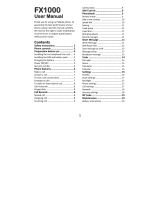
4
Unplug the charger from the electrical plug and the
device when not in use. Do not leave a fully charged
battery connected to a charger, since overcharging
may shorten its lifetime. If left unused, a fully charged
battery will lose its charge over time.
If the battery is completely discharged, it may take a
few minutes before the charging indicator appears on
the display or before any calls can be made. Use the
battery only for its intended purpose. Never use any
charger or battery that is damaged.
Do not short-circuit the battery. Accidental short-
circuiting will occur when a metallic object such as
a coin, clip or pen causes direct connection of the
positive (+) and negative (-) terminals of the battery.
This might happen, for example, when you carry
a spare battery in your pocket or purse. Short-
circuiting the terminals may damage the battery or the
connecting object.
Leaving the battery in hot or cold places, such as in a
closed car in summer or winter conditions, will reduce
the capacity and lifetime of the battery.
A device with a hot or cold battery may not work
temporarily, even when the battery is fully charged.
Battery performance is particularly limited in
temperatures well below freezing.
Do not dispose of batteries in a re as they may
explode. Batteries may also explode if damaged.
Dispose of batteries according to local regulations.
Please recycle when possible. Do not dispose as
household waste.
Note:
Actual operation time of the battery varies
according to operation mode, network settings and
call settings.





















